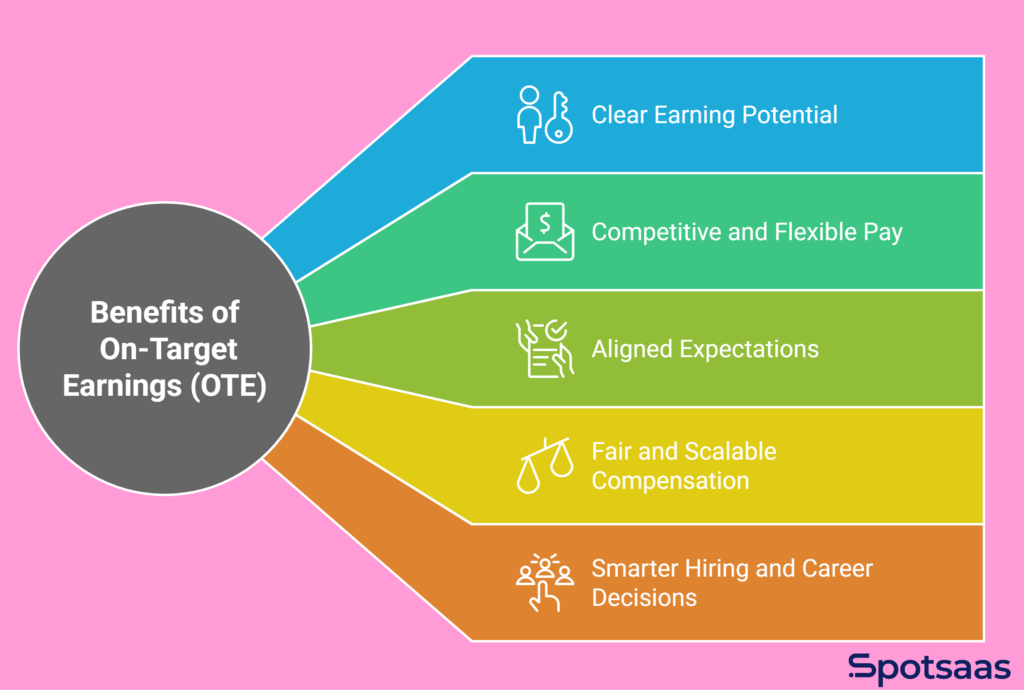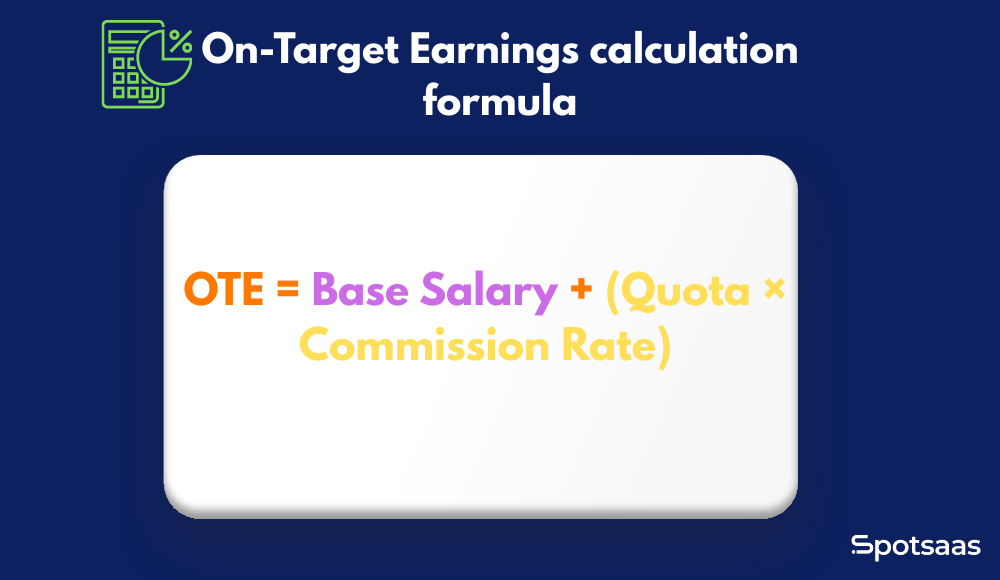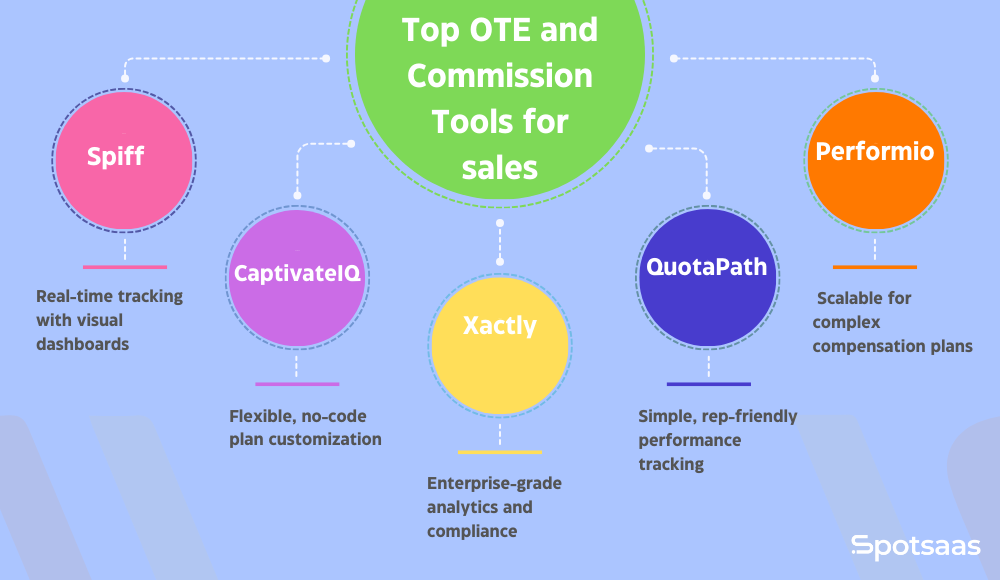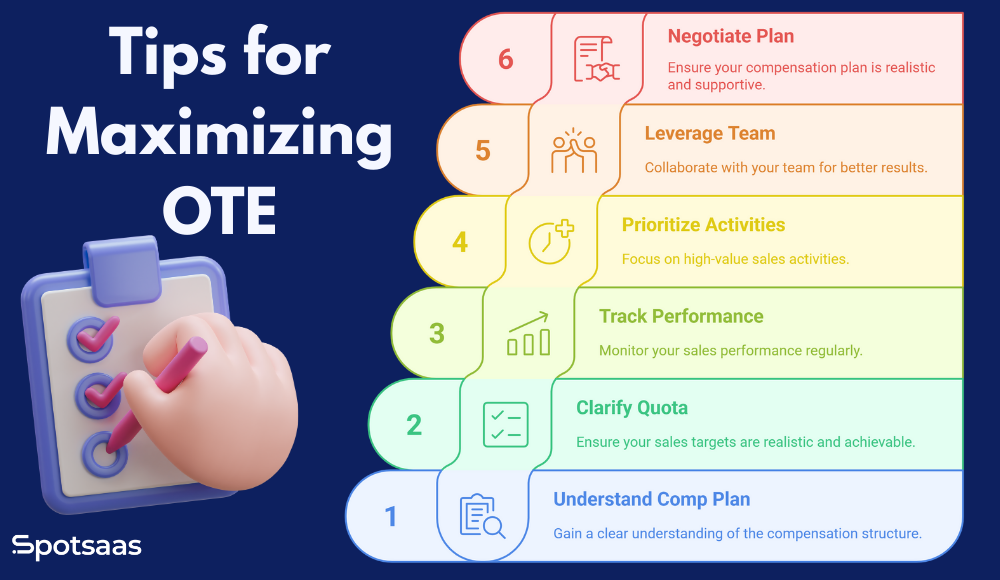When evaluating a sales role, one of the first numbers people look at is the On-Target Earnings (OTE). It sounds promising — but what does it really mean? And more importantly, how do you know if it’s realistic?
But knowing the number isn’t enough. You need to understand how it’s calculated, what influences it, and how to track it accurately.
In this blog, we’ll explain what OTE really means in 2025, walk through how to calculate it step by step, and explore the tools that make it easier to manage and optimize your sales compensation.
Don’t miss out; uncover how understanding OTE could transform your sales career trajectory!
Key Takeaways
- OTE combines base salary and commission to show total potential earnings in a sales role.
- Accurately calculating OTE helps set clear expectations for both employers and candidates.
- The formula for OTE is simple: Base Salary + (Quota × Commission Rate).
- Using commission tracking software brings clarity, accuracy, and trust to OTE-based roles.
- In 2025, having the right tools to manage OTE can improve motivation, retention, and results.
What Is On-Target Earnings (OTE)?
On-Target Earnings, or OTE, is a term used in sales compensation to reflect the total expected pay for a role if performance goals are met. It includes both the base salary and the variable earnings like commissions or bonuses tied to hitting targets.
OTE gives a full view of earning potential rather than just guaranteed pay. It helps sales professionals understand what they can realistically earn in a year, and helps employers offer competitive packages that reward performance.
For hiring managers, OTE is a strategic way to attract strong candidates without relying on high fixed salaries. For job seekers, it serves as a benchmark when comparing roles or negotiating offers, especially in commission-based industries.
Benefits of Understanding and Calculating OTE
In today’s fast-moving sales landscape, compensation clarity isn’t just a nice-to-have — it’s a competitive advantage.
When everyone involved understands how On-Target Earnings (OTE) works, it lays the groundwork for better hiring decisions, stronger team performance, and long-term retention. Here’s why OTE matters at every level.

Understand earning potential clearly
OTE helps candidates evaluate the full picture of a job offer — not just what they’ll earn by default, but what they can achieve through performance. Many sales job postings list a high OTE figure to attract attention, but without context, it’s hard to know whether that number reflects a real opportunity or a best-case scenario.
When candidates know how OTE is calculated including base salary, commission rates, and quota expectations they can assess whether the earning potential aligns with their skills and ambition. It builds trust early in the hiring process and empowers applicants to ask better questions during interviews.
Offer competitive pay with flexibility
For companies, OTE is a flexible way to create compensation packages that reward results without inflating fixed costs. Instead of raising base salaries across the board, employers can build structured incentives into OTE packages that drive performance and encourage growth.
This model also appeals to high-performing sales professionals who are motivated by clear, uncapped earning potential. A well-communicated OTE plan makes your offer stand out in a competitive hiring market especially in SaaS, tech, and other high-growth industries.
Align expectations from the start
Misunderstandings around compensation can lead to mistrust, disengagement, and even turnover. OTE helps eliminate that risk by aligning both sides around clear, measurable expectations. When a rep joins a company with full knowledge of how they’ll be compensated, it reduces guesswork and allows them to focus on hitting goals.
From the company’s side, a clearly defined OTE framework gives managers a tool to coach, motivate, and track performance in a way that directly ties to outcomes. Everyone knows the target, and everyone understands how success is rewarded.
Keep compensation fair and scalable
As teams grow, it becomes harder to maintain consistency without structure. OTE allows companies to scale compensation plans in a way that’s fair across roles, experience levels, and territories. With a consistent formula in place, there’s less room for negotiation loopholes or one-off exceptions that can create tension or resentment later on.
It also simplifies onboarding and internal promotions. New reps can quickly understand how pay works, and existing team members can see what it takes to level up, helping support both performance and retention.
Make smarter hiring and career decisions
OTE isn’t just about pay it’s a tool that helps both employers and employees make smarter decisions. Job seekers can quickly compare multiple roles by looking at the full earning potential, not just base pay. Hiring managers can use OTE to benchmark offers, justify compensation levels, and maintain alignment across departments like finance, HR, and sales.
The result? Fewer delays during the hiring process, fewer misunderstandings post-hire, and more confident decisions on both sides.
How to Calculate On-Target Earnings (OTE)
Understanding how to calculate On-Target Earnings is essential for building trust between employers and sales professionals.
It’s not just about the math — it’s about setting clear expectations and aligning pay with performance. Whether you’re hiring, interviewing, or reviewing a comp plan, getting this calculation right helps avoid confusion and creates transparency.
The Basic Formula
The formula to calculate OTE is straightforward:

Let’s break that down:
- Base Salary is the fixed annual amount a salesperson receives, regardless of performance.
- Quota refers to the sales target or revenue goal a rep is expected to hit over a defined period (usually monthly, quarterly, or yearly).
- Commission Rate is the percentage of closed deals or revenue that’s paid out as commission when a rep reaches their quota.
So, OTE represents what a salesperson would earn in total for the year if they meet 100% of their quota — combining guaranteed income with performance-based rewards.
Why This Calculation Matters
For candidates, knowing how to calculate OTE lets them evaluate job offers with clarity. A high OTE may seem attractive at first, but unless the quota and commission structure are realistic, the number could be misleading. Being able to run the numbers helps job seekers decide if a role is genuinely aligned with their earning goals.
For employers, calculating OTE properly ensures that compensation is motivating and tied to achievable performance. If OTE is inflated or unclear, it can create distrust and frustration.
On the flip side, a clear and well-structured OTE plan helps attract quality talent, especially in competitive sales environments like SaaS, tech, or B2B services.
Why Software Tools Help Track and Manage OTE Effectively
Manual methods like spreadsheets may work in the early stages, but as your sales team grows, they quickly become a bottleneck.
Software tools designed for OTE management not only improve accuracy and speed they also provide real-time insights and consistency that build trust across the team. The table below compares common pain points with the practical benefits of using compensation tracking software.
| Benefit | Problem Without Software | How Software Helps |
|---|---|---|
| Manual tracking leads to errors | Spreadsheets are error-prone and hard to scale | Automates calculations, reduces mistakes, syncs with CRMs |
| Real-time data drives motivation | Reps can’t track progress easily, reducing day-to-day focus | Live dashboards show quota status, commissions, and bonuses |
| Automation saves time and effort | Manual tracking drains time from ops and finance teams | Automates commissions, approvals, and reporting |
| Consistency builds team trust | Inconsistent rules cause confusion and frustration | Applies uniform compensation logic across all reps |
| Insights improve strategy | Limited visibility into plan or performance trends | Analytics reveal trends to optimize compensation plans |
| Better planning across teams | Disconnected data slows hiring and budgeting decisions | Unifies performance and payout data for smarter forecasting |
Common Misunderstandings About OTE
On-Target Earnings (OTE) is designed to create transparency around sales compensation, but in practice, it’s often misunderstood.
When companies aren’t clear about how OTE works, it can lead to misaligned expectations, confusion during the hiring process, and trust issues later on. Understanding these common missteps helps both employers and job seekers make better decisions.
OTE is mistaken
One of the most frequent misconceptions is treating OTE as a fixed salary. Job seekers sometimes assume that the OTE amount listed in a job post is what they’ll actually take home each year regardless of performance. This assumption can set the wrong expectation from day one.
In reality, OTE includes variable compensation that’s only earned if specific targets or quotas are met. If someone underperforms, they may only receive their base salary or a portion of their commission. That’s why companies need to clearly communicate that OTE is a target, not a guarantee.
For job seekers, asking the right questions — such as “What percentage of your team typically hits quota?” — can provide a more realistic picture of earning potential.
Unrealistic quotas
Another common issue is when companies promote attractive OTE numbers without disclosing how challenging the underlying targets are. A $150K OTE sounds compelling, but if the quota required to earn that is unreasonably high or unsupported by good leads and tools, it’s misleading.
Setting quotas that are not achievable for the average rep makes OTE numbers irrelevant in practice. If only a small percentage of the sales team ever hits target, the published OTE may do more harm than good — leading to poor morale, high turnover, and eventual loss of credibility.
Transparent companies will align OTE with historical performance data, making sure it reflects what top and mid-level performers are actually achieving in similar roles.
Commission Structure Isn’t Always Clear
Many job listings and compensation conversations include an OTE figure but skip over how commission is actually earned. Without visibility into the structure — such as how deals are credited, when commissions are paid, or whether there are caps or accelerators — it’s impossible to know if OTE is attainable.
This lack of detail leads to surprises later. A rep may close deals expecting a certain payout, only to find out commissions are delayed until clients pay invoices, or certain products don’t count toward their quota. This erodes trust and can result in compensation disputes.
To avoid this, employers should provide a clear breakdown of commission mechanics during the offer stage. Reps should also ask for written documentation outlining payment schedules, deal qualifications, and thresholds.
Same across very different roles
Sometimes companies use a one-size-fits-all OTE model across multiple roles or regions without adjusting for differences in territory, sales cycle length, or product complexity. This creates an imbalance — someone with a cold outbound territory might have the same OTE as someone with a warm inbound pipeline.
While standardizing compensation plans may seem efficient, failing to account for these variables can make OTE seem unfair. Reps working harder for less return may disengage or seek roles elsewhere, even if their skill set matches the job well.
The most effective OTE models consider role-specific factors and adjust quotas and commission structures accordingly. This ensures that everyone has a fair shot at hitting their target and earning what’s advertised.
Lack of communication and documentation
Even when an OTE model is well-designed, if it isn’t clearly communicated and documented, it can still lead to misunderstanding. Verbal promises or vague job descriptions aren’t enough. Candidates and team members need a clear, written explanation of how OTE is structured and earned.
This includes base salary, commission breakdown, quota expectations, payment timelines, and any bonuses or incentives. Sharing this early helps build confidence, and gives candidates the tools to make informed decisions — not just hopeful guesses.
For companies, clear documentation reduces back-and-forth, protects internal consistency, and lays the foundation for a healthy compensation culture and the math behind OTE, it becomes a tool for motivation — not confusion.
Top Tools for Managing OTE & Commissions
Manually managing On-Target Earnings (OTE) and commission plans might work for a small sales team, but it doesn’t scale. As your team grows, comp plans evolve, and targets change — spreadsheets become risky, time-consuming, and often inaccurate.
Below are some of the top-rated tools in the market, each with distinct strengths based on company size, complexity, and the level of customization required.

Spiff
Spiff is purpose-built for real-time commission tracking with a clean, user-friendly interface. It’s a favorite among high-growth companies that need automation without sacrificing speed or flexibility.
Spiff stands out for its fast onboarding, low learning curve, and highly visual dashboards that reps love. It takes the guesswork out of earnings and motivates performance with instant feedback.
Key features
- Real-time commission tracking for reps and managers
- Clean, intuitive dashboards that require minimal training
- Seamless integration with CRMs like Salesforce
- Easy plan updates without heavy coding or IT help
- Instant visibility into earnings and payout forecasting
Ideal for: Mid-size sales teams, tech/SaaS companies, and startups scaling quickly
CaptivateIQ
CaptivateIQ shines when comp plans are frequently updated or deeply customized. It’s a flexible platform with a no-code builder that allows finance and revenue teams to adapt quickly.
What sets it apart is how easily teams can launch new comp structures without waiting on engineering. CaptivateIQ is built for fast-moving environments where plans evolve regularly and compliance is critical.
Key features
- Highly customizable commission plan builder
- Automates complex calculations across roles and tiers
- Built-in workflows for approvals and payout reviews
- Strong audit trail and version control
- Deep reporting and analytics capabilities
Ideal for: Fast-scaling companies with complex, evolving comp plans
Xactly
Xactly is an enterprise-level platform with robust analytics and global scalability. It’s ideal for large companies that need advanced forecasting, modeling, and compliance built into their sales compensation engine.
It also supports long-term incentive planning and aligns pay structures with strategic growth goals. Xactly is built for organizations where compensation must be fully integrated into planning, reporting, and regulatory compliance.
Key features
- End-to-end incentive compensation management
- Advanced forecasting and modeling tools
- AI-driven recommendations to optimize comp plans
- Strong security, compliance, and audit functionality
- Scalable for global and multi-division use
Ideal for: Large enterprises or global companies with multi-layered sales structures
QuotaPath
QuotaPath focuses on simplicity and transparency. It’s designed for sales reps and managers who want a clear, real-time view of earnings tied directly to performance, without the need for technical setup.
Its user-friendly interface is great for first-time comp automation, helping teams move away from spreadsheets and towards consistent, trackable outcomes. If you want to empower reps to own their goals, QuotaPath makes it easy.
Key features
- Simple, rep-friendly dashboards
- Quota and earnings progress tracking in real time
- Goal-setting and incentive modeling tools
- CRM integrations to keep everything aligned
- Clear, mobile-friendly reporting
Ideal for: Small to mid-sized sales teams looking for ease and visibility
Performio
Performio offers advanced flexibility and is well-suited for companies managing multiple plans across complex sales structures. It combines automation with performance insights to keep plans efficient and scalable.
What makes Performio especially useful is its ability to adapt to both enterprise needs and mid-market use cases with granular control and scalable logic — all while keeping data audit-ready and secure.
Key features
- Handles complex comp plans with flexible logic
- Role-based access and user segmentation
- Real-time performance dashboards
- Workflow automation for approvals and adjustments
- Integrates with enterprise systems and CRMs
Ideal for: Organizations with layered or complex sales comp requirements
After reviewing the strengths of each platform, the comparison table below gives you a side-by-side view to help you decide faster.
It highlights how each tool stacks up in terms of customization, usability, analytics, and CRM integration making it easier to match the right solution to your team’s size and compensation needs.
| Tool | Best For | Customization | Ease of Use | Analytics & Reporting | CRM Integration |
|---|---|---|---|---|---|
| Spiff | Real-time visibility for growing teams | Moderate | Very Easy | Basic to Moderate | Yes (e.g. Salesforce) |
| CaptivateIQ | Complex, changing comp plans | High | Moderate | Advanced | Yes |
| Xactly | Enterprise-grade modeling & compliance | Very High | Moderate | Enterprise-Level | Yes |
| QuotaPath | Simplicity and rep-first usability | Low to Moderate | Very Easy | Moderate | Yes |
| Performio | Managing complex, layered plans | High | Moderate | Advanced | Yes |
Are OTE Jobs Worth It?
On-Target Earnings (OTE) jobs can offer great income potential, but whether they’re truly worth it depends on how the role is structured — and how well expectations are communicated.
When targets are clear, achievable, and supported by the right systems, OTE-based roles can be some of the most rewarding in a company. They give driven individuals a direct path to increasing their income, and for businesses, they’re a powerful way to align performance with compensation.
| Pros | Cons |
|---|---|
| ✅ High earning potential when targets are met | ❌ Income can vary based on performance and market conditions |
| ✅ Effort is directly tied to reward | ❌ Pressure to constantly hit sales quotas |
| ✅ Motivates competitive and performance-driven teams | ❌ Unrealistic targets may lead to burnout |
| ✅ Encourages goal setting and performance growth | ❌ May create internal competition if not managed well |
| ✅ Aligns pay with business outcomes and growth | ❌ Harder to predict monthly income, especially for new hires |
Tips for Maximizing OTE
Maximizing your On-Target Earnings (OTE) isn’t just about working harder — it’s about working smarter. Whether you’re in a new role or deep into a sales career, these strategies can help you stay aligned with your compensation plan and unlock more of your earning potential.

Understand the full comp plan
Your OTE isn’t just one number it’s made up of several moving parts. Take time to understand how your compensation breaks down: your base salary, commission rate, quota, bonuses, accelerators, and any caps that may apply.
Ask your manager or HR team for a clear breakdown and examples of how earnings change at different performance levels. Knowing exactly how your pay is structured puts you in control.
Clarify your quota
One of the most important (and most overlooked) parts of hitting OTE is knowing what it takes to get there. What’s your quota? How often do reps hit it? Is it adjusted based on territory, deal size, or seasonality?
If you’re unsure, ask. A realistic, data-driven quota is the foundation of any good OTE plan. If it’s not clear or achievable, your earnings potential takes a hit before you even begin.
Track performance in real time
Don’t wait until the end of the quarter to check your numbers. Stay on top of your performance weekly or even daily. Use your CRM or any compensation software provided to monitor your deal pipeline, quota progress, and upcoming renewals.
This helps you stay proactive — if you’re behind, you’ll know early enough to pivot and catch up. If you’re ahead, you can push further to unlock bonuses or accelerators.
Prioritize high-value activities
Time is your most valuable resource. Focus your energy on the activities that actually move the needle — whether that’s closing late-stage deals, following up with high-intent leads, or upselling existing accounts.
Not every deal is equal, and not every task is revenue-driving. The more time you spend in high-reward areas, the closer you get to maximizing your OTE.
Leverage your manager and team
You’re not in this alone. Your sales manager is there to help you hit your numbers. If you’re stuck on a deal, need a strategy shift, or feel off-track, ask for guidance.
Teams often have resources like sales engineers, marketing support, or internal champions that can help move deals forward. The most successful reps know when to lean on others — and how to collaborate to close smarter.
Negotiate the right plan
If you’re considering a new role, make sure the OTE being offered is realistic. Ask how quotas are set, how many reps actually earn full OTE, and what support systems are in place like inbound lead flow or CRM access.
A $120K OTE sounds great — but if only 10% of the team ever reaches it, that’s a red flag. It’s better to have a modest, achievable plan than a high number built on shaky foundations.
Conclusion
In conclusion, understanding on-target earnings (OTE) is crucial for sales professionals. OTE provides a clear picture of the earning potential and motivates reps to achieve their targets.
Understanding OTE isn’t just about knowing a number — it’s about knowing what it takes to earn it. When goals are realistic and clearly tied to compensation, OTE creates alignment, drives performance, and rewards results. Whether you’re applying for a role or building a sales team, treating OTE as a strategic tool — not a guess — makes all the difference.
Frequently Asked Questions
What is OTE in a sales job?
OTE, or On-Target Earnings, refers to the total expected earnings — base salary plus commission — that a salesperson can make by hitting their full quota. It’s a forecast, not a guarantee.
Is OTE the same as base salary?
No. Base salary is fixed pay, while OTE includes variable pay like commissions or bonuses tied to performance. OTE represents your full potential earnings if you meet goals.
How is OTE calculated?
The standard formula is:
OTE = Base Salary + (Quota × Commission Rate)
It shows what a rep would earn if they hit 100% of their target.
Should I negotiate OTE during a job offer?
Yes — but don’t just focus on the total number. Ask how often reps hit quota, how realistic it is, and what kind of support (leads, tools, CRM access) is provided.
Can OTE be trusted?
It depends. A trustworthy OTE is one backed by clear data, consistent quota attainment, and transparent commission plans. Always ask for past team performance and comp plan breakdowns before accepting an offer.



